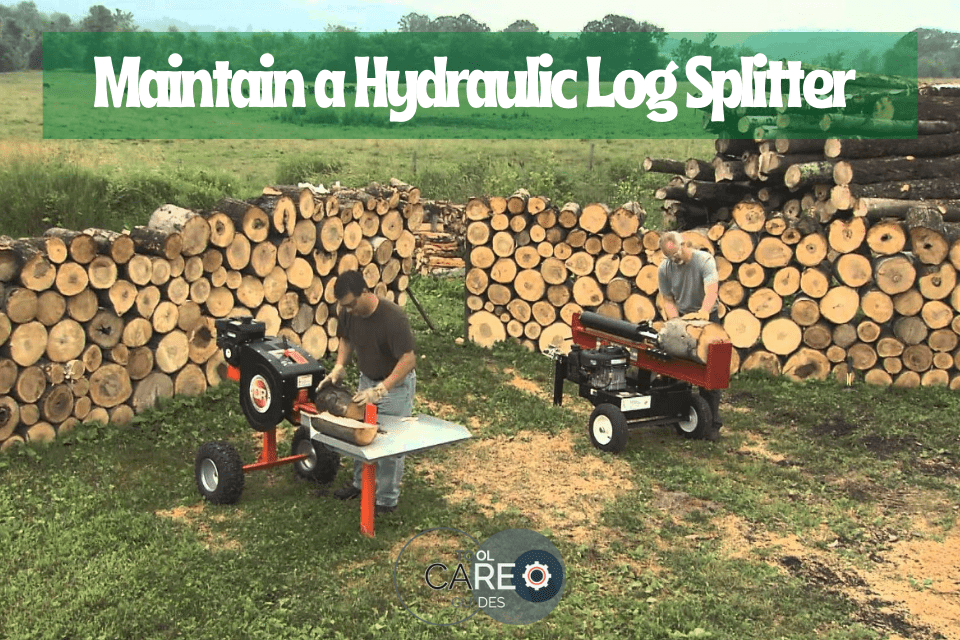Quick Overview of This Article
The use of hydraulic log splitters has become prevalent recently. The use of the traditional ways of the old axe and maul is long forgotten. Hence, hydraulic log splitter maintenance is essential for long-lasting purposes, among other multiple advantages. All kinds of equipment require the best maintenance and your hydraulic log splitter has no different.
There are two kinds of log splitters, the petrol log splitter and the electric one. In all kinds of log splitters, maintenance is essential. It does not matter whether you the petrol or the electric one; you must take good care of the equipment.
Read on to discover the best log splitters maintenance tips.
Best Power Tips for Hydraulic Log Splitter Maintenance
The steps outlined below consist of those particular aspects of Maintain Your Hydraulic Log Splitter.
- Read and understand the manual. Next, you should check the User Manual that comes with the equipment you purchase. Having a grasp of the information included therein is essential. Go through the make and version manual for complete details particular to your machine.
Always check the user manual if you find it hard to operate your hydraulic log splitter. It isn’t exciting to read the manual, but you need to follow the instructions provided thoughtfully. It is good to prepare how to operate the machine than to do anything costly later.
Perfect maintenance of Hydraulic Log Splitter is essential; it helps you use the log splitter for the long term. The manual provides with the things to do and those to avoid for your machine maintenance.
- Examine for hydraulic fuel leakage. You can use a cardboard but it is best if you choose a professional practice in this case. Do this by clearly setting the pressures, inserting accumulators, and shock suppressors where necessary.
You should confirm that the system has proper piping, inspect the hoses, and add or tighten pilot chokes. Further, you should minimize or even do away with shock and leakage in your hydraulic log splitters.
Inspect the hoses and the pipes frequently. The pressure hoses or pipes transfer the hydraulic fluid from the tank to the machine’s cylinder which leads to the addition of pressure inside the machine. You are supposed to inspect it regularly for signs of leaking.
It is not ideal to fill it by yourself since the pressure is very strong and can cause harm to you.
- Fill the hydraulic fluid tank. You are required to open the hood and search for the hydraulic tank. You will locate it with a vented fill cap with a sight glass or fill gauge beside it to show the fluid level. Provide the fluid.
You must remove the vented fill cap, add the oil into the fill tube, and pump the liquid into the tank. Hydraulic fluid is generally the central element in your log splitter. Therefore, do not allow the level to stay low and confirm it regularly.
In the case of preserving the correct fluid level, you need to detach the oil filing cap, confirm levels and fill it if necessary. In addition, professionals recommend hydraulic fluid change after every 100 hours. Also, ensure to Use Fresh Hydraulic Fluid always.
Often, check your hydraulic fluid tank for water. Water pollution in your hydraulic fluid can add up with time. The contaminated hydraulic fluid will rapidly reduce your effective process of wood splitting. In addition, as you split your wood occasionally, it will lead to a poorly operating log splitter.
If you see any sign of milky grey pollution in your hydraulic fluid, drain and change it with new fluid.
- Check the User Manual for air removal from a hydraulic cylinder. There is still another process after filing your hydraulic fluid. First, you must remove the trapped air from the cylinder.
To succeed, you need to expand the piston rod to its full length and detach the oil filling plug. Then, immediately, twist the release screw in a counterclockwise movement in relative speed. It will lead the piston rod to drawback in the cylinder, which will let out the trapped air.
The process is essential for Hydraulic Log Splitter Care.
- Ensure to clean the log splitter regularly. When purchasing a hydraulic log splitter, consider choosing the one you can easily wash at your comfort. Cleaning a hydraulic log splitter consists of a process involving removing oil, grease, and debris.
Cleaning debris around the machine is essential to prevent substances from getting trapped inside the machine. Check the Engine and ensure the device is not running when carrying out the cleanliness practices.
- Ram is a significant part of the hydraulic log splitter. During the process of hydraulic Log, Splitter Maintenance ensures to Lubricate the Ram. Lubricate the Ram.
Ensure the ram is properly greased. The manual has added the ram as an essential part for your hydraulic log splitter, so maintain it and keep it rust-free by adding a lot of grease on it. Signs of rust should be removed instantly with sandpaper then smeared oil.
Clean the ram and get rid of all the dust, rust, and grease that has clogged in it. In addition, all the rust visible on the ram should be wiped off and ensure the entire item is clean. This process will assist in increasing the life span of your hydraulic log splitter.
Rusted rams will cause problems to your hydraulic seal; it is not worth damaging your seal. If you notice any signs of sand or dust forming on the ram, clean it instantly.
- Examine the pull cord. Detach the pull cord, bring it outward, and check its full length of wear and tear. Cords do wear out and become weak over time, and I know you are not prepared to have yours broken when you require it most.
Immediately you realize wearing out of the pull cord, purchase a new cord and replace it with the weary one.
- Inspect the pump. When you check the user manual, it shows you that the engine powers the pump in your hydraulic system. Typically, it uses a power take-off; you should examine the coupling to prevent loose play by combining to run it.
If possible, inspect the middle lever of your pump to confirm it is not getting loose. Then, if you can adjust the parts, you can change the bearings.
- Polish the blade. Any sign of dullness or spots on the edge of your blade means you need to sharpen it using a coarse metal first. To bring back the blade to its original point of sharpness, use the coarse file to sharpen the blade.
Complete the activity by using a metal file together with the edge of the blade.
- Check the Engine. In this case, the hydraulic log splitter has a gas engine. You should also check the cords. If you use a gas engine to provide power for your hydraulic log splitter, maintain its cleanliness and ensure it is filled with oil. Confirm that every part of the valve and the lever are appropriately lubricated.
Consider getting a self-lubricating hydraulic log splitter if you want more minor problems while splitting wood with your log splitter. Also, keep a close inspection on the carburetor to ensure your machine’s efficiency.
The cords are to be checked for possible wear and tear and changed before re-using them.
- Inspect the pump. Never forget to check the pump for some loose play in the connection. If much loosening happens, it can stop the pump from working well. Consequently, you need to change the bearings if it begins to create a disorder.
If you get signs of loose play in the middle spindle and connection, they are in most cases caused by broken bearings.
- Place in a dry environment. Your log splitter needs to be stored in a dry place to prevent water and rust damage. You can use the garage; it is a perfect place for storing your hydraulic log splitter.
The garage can maintain your equipment always and keeps dryness entirely. In addition, the use of waterproof material is also an excellent way to prevent your hydraulic log splitter from being ruined by water and dust.
- Replace worn-out hydraulic log splitter parts. Change the weary parts of your log splitter immediately you realize their deficiency. Using the log splitter with such features is not advisable.
When changing the parts, make sure they match, look at the part and the model number before buying the new features. Confirming such details helps in buying the exact part needed for your hydraulic Log splitter.
Inspect the hoses regularly; they are very critical in such a process of changing to new ones. Ensure there is no issue of coiling or flat points. Consequently, if you realize they are behaving in a worn-out manner or notice a potential puncture, it is not worth the loss; replacement is the best option.
If you suspect leakage, it would be beneficial for you to confirm with a piece of paper or cardboard and change the hoses with the new ones. These king of need the following tools in your toolbox;
- Adjustable wrench
- Combination wrench
- Side cutting pliers
- Needle-nose pliers
- Allen-wrench
- Earmuffs
- Now that you gained knowledge of the best log splitters maintenance tips, you are ready to operate the machine directly. Check the user manual frequently to ensure proper you correctly carry out the hydraulic log splitter care & maintenance process.
If you follow the manual instructions, your log splitter will operate correctly and effectively, so you can split wood without any challenges.
- Signs of defects. As you operate your log splitter, clearly listen for sounds that are not common or for excess vibrations. Vibration is the main factor indicating that your log splitter is not perfect.
The only origin of excess vibration is the hydraulic pump and the Engine. Finally, worry less; it is impossible to have several defects to deal with at once. Regularly check the user manual to avoid such problems. You are supposed to consider hydraulic log splitter maintenance as a significant activity.




